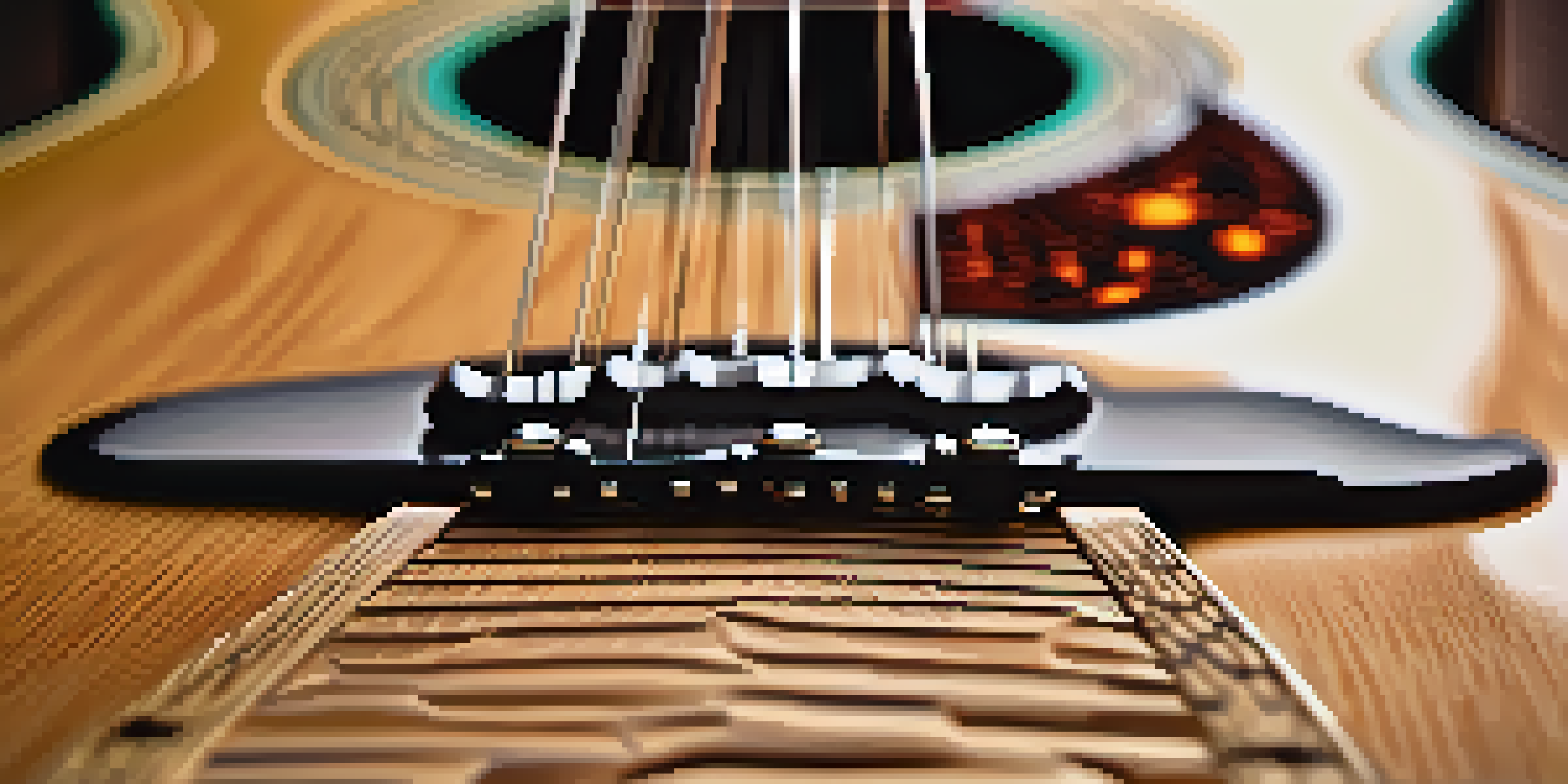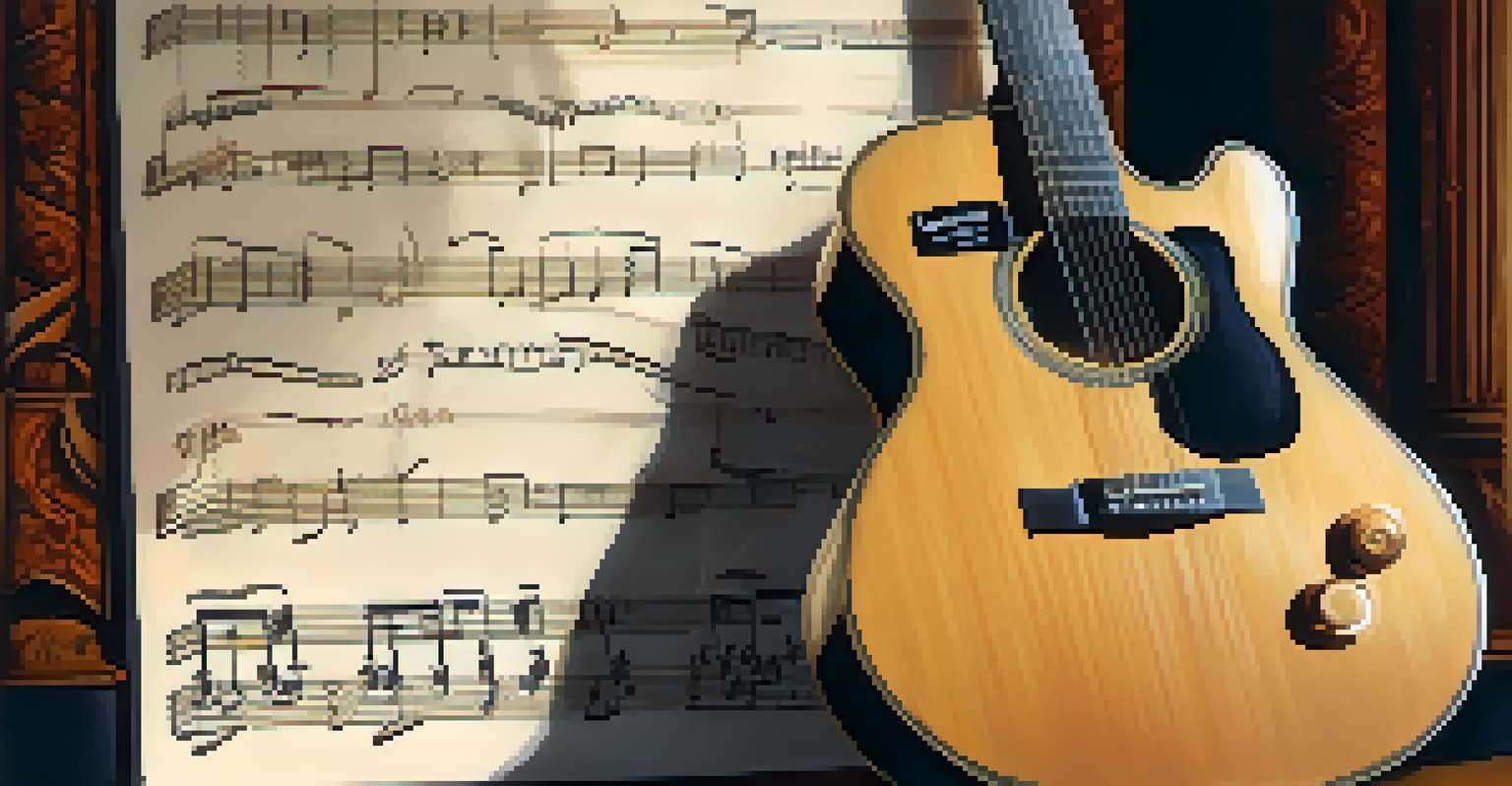A Comprehensive Guide to Guitar Bridge Construction

Understanding the Role of the Guitar Bridge
The guitar bridge is a crucial component that helps transmit vibrations from the strings to the body of the instrument. It significantly influences the guitar's tone and sustain, making its construction vital for optimal sound quality. Essentially, the bridge acts as the anchor point for the strings, providing stability and support.
The guitar is a miniature orchestra in itself.
Different types of bridges exist, such as fixed, tremolo, and floating bridges, each serving unique purposes. For instance, a fixed bridge is known for its stability and ease of tuning, while a tremolo bridge allows for pitch bending, adding expressive capabilities. Understanding these differences can help you choose the right type for your playing style.
When constructing a guitar bridge, materials also play a pivotal role in shaping the sound. Common materials include wood, metal, and composite materials, each contributing distinct tonal characteristics. Exploring these options can lead to a deeper appreciation of how a bridge affects overall guitar performance.
Key Materials for Guitar Bridge Construction
Choosing the right materials for your bridge is fundamental to achieving the desired sound. Traditional materials like rosewood and maple are popular for their tonal properties, offering warmth and clarity. However, some modern builders are experimenting with materials like carbon fiber for enhanced durability and consistency.

Another consideration is the bridge saddle, which is typically made from materials such as bone, plastic, or brass. Each material has its own effect on tone and sustain, so it’s essential to select one that complements your guitar's overall sound profile. For example, bone saddles are often favored for their ability to enhance clarity and resonance.
Guitar Bridge Impact on Sound
The construction and materials of a guitar bridge significantly influence its tone and sustain.
Additionally, the finish of the bridge can influence its performance. A well-sealed bridge can prevent moisture absorption, which is crucial for maintaining its structural integrity over time. This attention to detail can significantly extend the life of your instrument and enhance its playability.
Designing the Perfect Guitar Bridge Shape
The shape of your guitar bridge can significantly impact its function and aesthetic appeal. Popular designs include the traditional flat-top bridge and the more modern arch-top bridge, each providing unique advantages. The choice of shape often depends on the style of music you play and your personal preferences.
It's all about the tone and feel of the instrument.
Curved bridges, for instance, can help with string height adjustments, allowing for better playability and comfort. On the other hand, flat bridges are often easier to build and can provide a more straightforward setup. When designing your bridge, consider how its shape will interact with the strings and the overall tone.
Experimenting with different bridge shapes can lead to exciting discoveries about your guitar’s sound. As you explore various designs, think about how each one affects string vibration and resonance. This exploration can be a fun and rewarding process, ultimately enhancing your playing experience.
Bridging Techniques: Gluing and Fastening
When it comes to attaching the bridge to the guitar body, utilizing the right gluing techniques is paramount. The adhesive you choose can affect not only the bond's strength but also the instrument's resonance. Many builders opt for high-quality wood glue, which provides a strong yet flexible bond, allowing the wood to vibrate freely.
In addition to gluing, some builders may choose to use mechanical fasteners for added security. Screws or dowels can reinforce the bond, especially in high-stress areas. However, it's essential to ensure that any mechanical fastening does not interfere with the bridge's vibration or the guitar's overall sound quality.
Importance of Proper Alignment
Proper alignment during the bridge attachment process ensures accurate intonation and enhances playability.
Proper alignment during the gluing process is critical for maintaining the guitar's intonation. Using jigs or templates can help achieve precise positioning, ensuring that the bridge is perfectly centered. Taking these extra steps will pay off in the long run, resulting in a well-constructed instrument that plays beautifully.
Adjusting Action and Intonation for Optimal Playability
Once your bridge is constructed and attached, fine-tuning the action and intonation is essential for optimal playability. Action refers to the height of the strings above the fretboard, and finding the right balance can enhance your playing experience. Low action can make playing easier, while higher action can improve tone and volume.
Intonation is equally important, as it affects how well your guitar stays in tune across the fretboard. A properly set bridge will allow you to adjust the saddle position to ensure that each note rings true. This adjustment process often involves trial and error, so patience is key while you work to achieve the perfect setup.
Regular maintenance, such as checking action and intonation, can prevent issues down the line and keep your guitar performing at its best. By investing time in these adjustments, you not only improve playability but also enhance the overall sound of your instrument.
Common Mistakes in Guitar Bridge Construction
Even experienced builders can make mistakes when it comes to guitar bridge construction. One common error is using inadequate glue or applying too much, which can lead to weak bonds or messy finishes. Taking the time to select the right adhesive and applying it correctly will save you trouble later on.
Another frequent misstep is neglecting to consider the bridge's height and angle, which can impact action and intonation. Failing to account for these factors can lead to a frustrating playing experience and diminished sound quality. Always double-check measurements and alignments before finalizing your bridge.
Maintenance for Long-lasting Bridges
Regular maintenance and cleaning are essential to keeping your guitar bridge in optimal condition and extending its lifespan.
Lastly, overlooking the importance of testing and adjusting after construction can lead to missed opportunities for improvement. Regularly assess your bridge's performance and make necessary changes to enhance playability and sound. Embracing a mindset of continuous learning will help you grow as a builder.
Maintaining Your Guitar Bridge for Longevity
Proper maintenance is key to ensuring your guitar bridge remains in good condition over time. Regularly checking for signs of wear, such as cracks or loosening, can help you catch potential issues early. A little preventative care goes a long way in keeping your instrument playing beautifully.
Cleaning your bridge and saddle is equally important, as dirt and grime can affect sound quality. Gently wiping down these areas with a soft cloth can help maintain their appearance and functionality. Avoid using harsh chemicals that could damage the wood or finish.

Finally, consider environmental factors that can impact your bridge's longevity. Extreme temperatures and humidity can cause wood to swell or shrink, leading to structural issues. Keeping your guitar in a controlled environment can help prevent these problems and ensure your bridge remains solid for years to come.